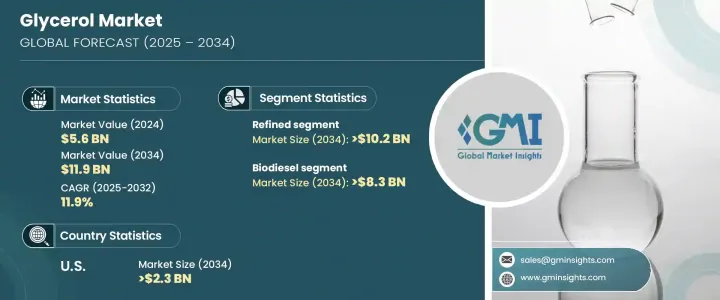
세계 글리세롤 시장은 2024년에 56억 달러로 평가되었으며, 2025년부터 2034년까지 11.9% 이상의 CAGR로 성장할 것으로 예측됩니다.
글리세롤 수요는 퍼스널케어, 의약품, 음식, 바이오연료에서의 역할에 의해 높아지고 있습니다. 완화, 윤활 및 보습 특성으로 스킨케어, 헤어케어, 구강 관리 제품의 핵심 성분입니다. 소비자의 자연파 화장품이나 유기농 화장품으로의 이행이 진행되고 있어 동식물 유래의 글리세롤 수요에 박차를 가하고 있습니다.

산업계가 지속가능성과 바이오 솔루션을 수용함에 따라 글리세롤의 중요성은 확대되고 있습니다. 조직을 지원하고 있으며, 재생가능에너지 유래의 글리세롤에 대한 투자 기회를 창출하고 있습니다.
| 시장 범위 | |
|---|---|
| 시작 연도 | 2024년 |
| 예측 연도 | 2025-2034년 |
| 시작 금액 | 56억 달러 |
| 예측 금액 | 119억 달러 |
| CAGR | 11.9% |
정제 글리세롤은 2024년에 46억 달러 이상을 차지했으며, 2034년에는 102억 달러 이상에 달할 것으로 예상됩니다. 그럼에도 불구하고 바이오 디젤 생산이 확대됨에 따라 글리세롤 기반 연료에 대한 수요가 증가하고 있으며 바이오 화학 물질, 부동액, 플라스틱 및 용매의 개발을 지원합니다.
바이오디젤 부문은 글리세롤 생산에 크게 기여하고 있으며, 시장 점유율은 2024년에 약 69.8%에 달할 전망입니다. 재생 에너지원에 대한 의존 증가와 탄소 풋 프린트를 최소화하는 노력이 바이오 디젤 산업의 성장을 뒷받침하고 있습니다.
지방산에서 유래하는 글리세롤은 윤활유, 계면활성제, 에스테르의 생산에 중요한 역할을 하고 있습니다.그 범용성은 다양한 화학 및 공업 용도를 지지하고 있습니다.
글리세롤을 재빨리 이용한 산업의 하나로, 비누나 클렌징 제품의 제조가 있습니다.그 보습성에 의해 퍼스널케어 제품에 빠뜨릴 수 없는 것이 되고 있습니다.
미국에서는 글리세롤 시장이 2024년에 10억 달러를 넘어 2034년에는 23억 달러 이상에 달할 것으로 예상되고 있습니다. 바이오 베이스의 화학물질이나 글리세롤에스테르와 같은 비전통적인 글리세롤 유도체의 채용이 증가하고 있어 공업 프로세스의 재구축이 진행되고 있습니다.
The Global Glycerol Market was valued at USD 5.6 billion in 2024 and is projected to grow at a CAGR of over 11.9% from 2025 to 2034. The demand for glycerol is rising due to its role in personal care, pharmaceuticals, food and beverages, and biofuels. Its emollient, lubricating, and moisturizing properties make it a key ingredient in skincare, haircare, and oral care products. Consumers are increasingly shifting toward natural and organic cosmetics, fueling demand for plant- and animal-based glycerol.

The importance of glycerol has expanded as industries embrace sustainability and bio-based solutions. It is a byproduct of biodiesel production, aligning with the global push for renewable energy. Governments worldwide are supporting green chemistry initiatives, creating opportunities for investment in glycerol derived from renewable sources. Industries focused on sustainability stand to benefit from policies that promote environmentally friendly production methods, fostering long-term returns while contributing to economic and ecological benefits.
| Market Scope | |
|---|---|
| Start Year | 2024 |
| Forecast Year | 2025-2034 |
| Start Value | $5.6 Billion |
| Forecast Value | $11.9 Billion |
| CAGR | 11.9% |
Refined glycerol accounted for over USD 4.6 billion in 2024 and is expected to surpass USD 10.2 billion by 2034. This variant is essential in pharmaceuticals, food processing, and cosmetics. While crude glycerol has industrial applications, its lower economic value stems from the need for extensive purification. Despite this, demand for glycerol-based fuels is increasing as biodiesel production expands, supporting the development of bio-based chemicals, antifreeze, plastics, and solvents.
The biodiesel sector is a major contributor to glycerol production, with its market share reaching approximately 69.8% in 2024. By 2034, glycerol from biodiesel is expected to generate over USD 8.3 billion in revenue. The rising reliance on renewable energy sources and efforts to minimize carbon footprints drive the biodiesel industry's growth. Higher glycerol yields from biodiesel manufacturing reduce costs while ensuring a stable supply for pharmaceuticals, cosmetics, and food applications.
Glycerol derived from fatty acids plays a crucial role in producing lubricants, surfactants, and esters. Its versatility supports various chemical and industrial applications. Additionally, glycerol is a key component in the formulation of emulsifying agents, detergents, and plasticizers. Fatty alcohol-based glycerol is gaining traction due to the growing demand for environmentally friendly alternatives.
One of the earliest industries to utilize glycerol is soap and cleansing product manufacturing. Its humectant and moisturizing properties make it indispensable in personal care formulations. The shift toward sustainable and natural ingredients has further amplified its relevance.
In the United States, the glycerol market exceeded USD 1 billion in 2024 and is anticipated to surpass USD 2.3 billion by 2034. Expanding applications across food, pharmaceuticals, personal care, and biofuels are driving market growth. The increasing adoption of bio-based chemicals and nontraditional glycerol derivatives, such as glycerol esters, is reshaping industrial processes. The preference for natural and organic ingredients in the cosmetics sector further strengthens the market's outlook.